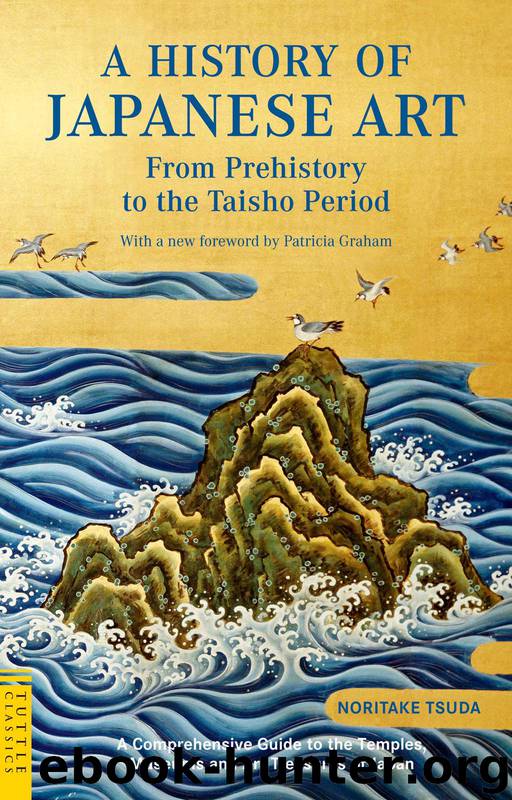A History of Japanese Art by Noritake Tsuda

Author:Noritake Tsuda
Language: eng
Format: epub
ISBN: 978-1-4629-1678-8
Publisher: Tuttle Publishing
Fig. 148. Lady, by Kwaigetsudō Andō
Tokyo Imperial Household Museum
In the third period (1741-1843), a remarkable development was made in what is called crimson prints, or beni-e; and then further development was achieved in what is called nishiki-e; or brocade-picture.
But before describing these two kinds of color prints and their artists we shall pause here to see the unique processes by which Japanese color prints are made, so that our readers may understand why they deserve so much fame throughout the world.
First of all, it must be understood that the color print is not a reproduction of a picture in colors. It is entirely different from a colored reproduction. Any reproduction of a famous painting is necessarily inferior to the original; and no one will take it for the original. But in the Ukiyo-e print, the case is entirely different. There is no independent colored picture to be reproduced by printing. The Japanese color print is produced by the co-operation of three different artists; that is, the painters, the engraver, and the printer. The painter first draws a picture in black and white, this being known as the shita-e or “found picture.” Then the engraver transfers this foundation picture to the block. What colors are to be applied to what portions of the picture are noted by the painter in letters. Then the printer actually applies the colors to the blocks, so as to get the desired effects.
The lines in color prints are very different from those drawn by painters with brushes. The lines traced on the blocks express the skill of the engraver, and assume quite a different beauty from that of brush painting. The painter of the original lines must consider what kinds of lines will get the best effect when they are transferred to the block by his engraver. Therefore, the characteristics of the lines of the color prints depend mostly upon the engraver. But the final finish is achieved by the printer. The printers transfer the lines to the paper by pressing them with a kind of pad called baren. The pressing of the colors gives them a certain fine luster which can never be obtained by hand coloring.
It will now be clearly understood that in making up a color print three artists—the painter, the engraver, and the printer—must co-operate closely from the beginning to the end. When the three co-operate well, the best kind of Ukiyo-e print will be produced; and it deserves higher appreciation than does the painting. This is the reason why Japanese color prints are so highly prized.
As has been said, in the period from Enkyō (1744-1747) to Hōreki (1751-1763) the first step of progress was made in what is called beni-e color print. Beni-e literally means crimson picture. The principal color of the beni-e print is a soft vegetable pink. The pink is generally used in contrast with green, yellow, and some other colors. But the colors are not graded so as to get beautiful tints and shades as they are in the brocade picture which developed later.
Download
This site does not store any files on its server. We only index and link to content provided by other sites. Please contact the content providers to delete copyright contents if any and email us, we'll remove relevant links or contents immediately.
| Africa | Americas |
| Arctic & Antarctica | Asia |
| Australia & Oceania | Europe |
| Middle East | Russia |
| United States | World |
| Ancient Civilizations | Military |
| Historical Study & Educational Resources |
The Rape of Nanking by Iris Chang(3516)
The Sympathizer by Viet Thanh Nguyen(3478)
World without end by Ken Follett(3006)
Ants Among Elephants by Sujatha Gidla(2924)
Blood and Sand by Alex Von Tunzelmann(2608)
Japanese Design by Patricia J. Graham(2555)
City of Djinns: a year in Delhi by William Dalrymple(2135)
Inglorious Empire by Shashi Tharoor(2100)
Foreign Devils on the Silk Road: The Search for the Lost Treasures of Central Asia by Peter Hopkirk(2055)
In Order to Live: A North Korean Girl's Journey to Freedom by Yeonmi Park(2052)
Tokyo by Rob Goss(2016)
India's Ancient Past by R.S. Sharma(1986)
India's biggest cover-up by Dhar Anuj(1982)
The Great Game: On Secret Service in High Asia by Peter Hopkirk(1960)
Tokyo Geek's Guide: Manga, Anime, Gaming, Cosplay, Toys, Idols & More - The Ultimate Guide to Japan's Otaku Culture by Simone Gianni(1945)
Goodbye Madame Butterfly(1934)
The Queen of Nothing by Holly Black(1752)
Living Silence in Burma by Christina Fink(1728)
Batik by Rudolf Smend(1719)
